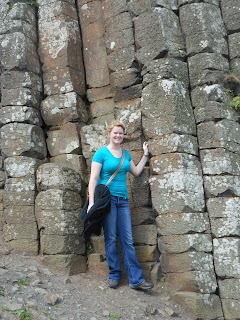Month 2 of my journey was spent in Northern Ireland, the
part of the Isle of Ireland that is a part of the United Kingdom. Because of
their ties to the UK, the Northern Irish are much more culturally “British”
than the Republic of Ireland. Many of
the people in NI are of Scottish descent, and thus many of their customs are
the same, including their agricultural practices. Though agriculture is quite
similar in N. Ireland to that of Scotland, I have noticed more dairies in
Northern Ireland and fewer sheep. Cattle are dominant, and field sizes are
usually around 10 acres or less. Instead of Scotland’s stone fences there are hedges
as far as the eye can see. Hedge borders are everywhere alongside roads and between
fields. They are often quite tall and make it virtually impossible to look into
fields, giving the average nosey farmer a tough time. Grass silage is the most common livestock
feed grown with just a few cereal grains grown for feed.
Food isn’t too
different from Kansas, usually meat and potatoes. Boiled potatoes are essential
to every meal, and alcohol with meals is more prevalent. Whiskey is consumed on
a regular basis in many families. Meal
times aren’t always at the same time from day-to-day, dinner could be at 11pm
if that is how it happens, as it did several times during my stay. Punctuality
isn’t bothered with much all-in-all.
Times are often set earlier than they are meant for just so people may
end up finally arriving on time. For example, a club may set their meeting time
as “half seven for eight”, meaning try to show up at 7:30 for the meeting at 8,
though this often results in people showing up at 8:30. Some cultures are more
insistent on punctuality, but in N. Ireland the “take it easy” attitude on time
teaches you to just go with the flow.
One thing that is consistent throughout the UK is having a
“cuppa” tea. Tea is taken quite seriously, and some families would have around
six or more tea breaks a day. Tea would be drank following breakfast, mid-morning,
following lunch, early afternoon, mid-afternoon, following dinner, and then at
least one cup before bed. The most common tea is English Breakfast, and is
almost always served with milk, and then sugar if preferred.
Many of the people in
N. Ireland are still very much at odds with each other on religion, even after
hundreds of years of holding grudges. Protestant vs. Catholic is at the basis
of all decisions, and there are cities such as “Londonderry” (Protestant
preferred city name) a.k.a. “Derry” (Catholic preferred city name) where the cities
are segregated by walls or rivers due to their religious differences. There are many parades and “celebrations” throughout
N. Ireland that display one religion’s dominance in an area, while essentially
deepening an already existent grudge with their Protestant or Catholic
neighbors. The youth of Northern Ireland are
slightly more forgiving of the conflicts of the past and may have a friend or
two of a different religion. Some people in Northern Ireland say they can tell
the difference in a person’s religion just by looking at them, though they’d
have the same hair style and clothing style as anyone else.
From where I was
standing I would have never been able to see the difference.






















.jpg)





